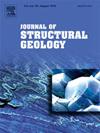Late Quaternary left-slip rate of the Dangjiang segment along the Ganzi-Yushu-Xianshuihe Fault Zone in the central Tibetan Plateau and the tectonic implications
IF 2.9
2区 地球科学
Q2 GEOSCIENCES, MULTIDISCIPLINARY
引用次数: 0
Abstract
The Dangjiang segment, as the northwestern extremity of the NW-NNW-trending sinistral-slip Ganzi-Yushu-Xianshuihe Fault Zone (GYXFZ) in the central Tibetan Plateau, plays an important role in absorbing strain and regulating the relative movement between active blocks of the Tibetan Plateau interior. However, the late Quaternary strike-slip rate of the Dangjiang segment has rarely been studied because of extreme weather and hypoxia in high-altitude areas (H > 5000 m) and inconvenient transportation, which directly affects the scientific understanding of the tectonic deformation style and reasonable assessment of the strong earthquake hazard along the GYXFZ and the analysis of the present deformation characteristics and geodynamic process of the plateau. Therefore, this study investigated the active tectonics of the Dangjiang segment based on integrated data from high-resolution satellite interpretation, large-scale geomorphic and geological mapping, trench excavations, and Quaternary chronological dating. The results reveal that the Dangjiang segment branches into the main Dangjiang Fault and secondary Zhiduo Fault, both of which have experienced intensive left-strike slip with minor dip movement since the late Quaternary. By measuring offset tributary terraces of the Tongtian River using a UAV survey, and dating their abandonment age using OSL and 14C with the upper terrace model, the late Quaternary strike-slip rate of the Dangjiang Fault and the Zhiduo Fault were estimated at ∼6.9 ± 0.1 mm/a and ∼2.1 ± 0.2 mm/a, respectively. Both the linear fitting value and the slip decomposition model indicate that the strike-slip rate of ∼8–10 mm/a in the late Quaternary is more consistent with geological and geomorphic estimations as well as geodetic constraints along the GYXFZ, and that the late Quaternary slip rate (∼8–10 mm/a) is consistent with the long-term and average slip rates along the structure. This spatiotemporal variation suggests that the current tectonic deformation of the Tibetan Plateau interior may have been continuous and distributed.
青藏高原中部甘孜—玉树—鲜水河断裂带当江段晚第四纪左滑速率及其构造意义
当江段作为青藏高原中部nw - nnw走向的甘孜-玉树-鲜水河左滑断裂带(GYXFZ)的西北端,在吸收应变和调节青藏高原内部活动块体之间的相对运动中起着重要作用。然而,由于高海拔地区的极端天气和缺氧,对当江段晚第四纪走滑速率的研究很少(H >;这直接影响了对GYXFZ沿线构造变形样式的科学认识和强震危险性的合理评价,以及高原现今变形特征和地球动力过程的分析。为此,本研究基于高分辨率卫星解译、大尺度地貌地质填图、海沟挖掘和第四纪年代学等综合资料,对当江段的活动构造进行了研究。结果表明,当江段分为主当江断裂和次级治多断裂,两者晚第四纪以来均经历了强烈的左走滑和轻微的倾移运动。利用无人机(UAV)测量通天河支流偏置阶地,并利用OSL和14C(上阶地模型)确定其废弃年龄,估算出党江断裂和知多断裂晚第四纪走滑速率分别为~ 6.9±0.1 mm/a和~ 2.1±0.2 mm/a。线性拟合值和滑动分解模型均表明,晚第四纪(~ 8 ~ 10 mm/a)的走滑速率与GYXFZ沿线的地质、地貌估算和大地测量约束更为吻合,而晚第四纪(~ 8 ~ 10 mm/a)的滑动速率与沿构造的长期和平均滑动速率一致。这种时空变化表明青藏高原内部现今的构造变形可能是连续的、分布的。
本文章由计算机程序翻译,如有差异,请以英文原文为准。
求助全文
约1分钟内获得全文
求助全文
来源期刊

Journal of Structural Geology
地学-地球科学综合
CiteScore
6.00
自引率
19.40%
发文量
192
审稿时长
15.7 weeks
期刊介绍:
The Journal of Structural Geology publishes process-oriented investigations about structural geology using appropriate combinations of analog and digital field data, seismic reflection data, satellite-derived data, geometric analysis, kinematic analysis, laboratory experiments, computer visualizations, and analogue or numerical modelling on all scales. Contributions are encouraged to draw perspectives from rheology, rock mechanics, geophysics,metamorphism, sedimentology, petroleum geology, economic geology, geodynamics, planetary geology, tectonics and neotectonics to provide a more powerful understanding of deformation processes and systems. Given the visual nature of the discipline, supplementary materials that portray the data and analysis in 3-D or quasi 3-D manners, including the use of videos, and/or graphical abstracts can significantly strengthen the impact of contributions.
 求助内容:
求助内容: 应助结果提醒方式:
应助结果提醒方式:


